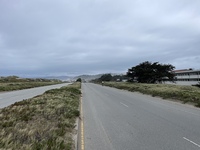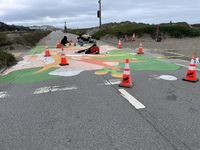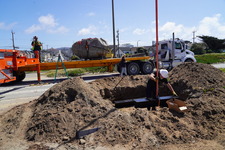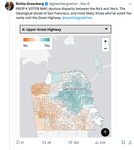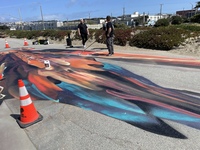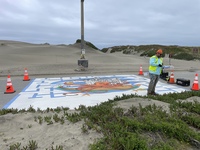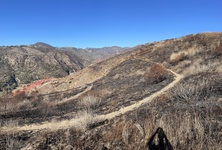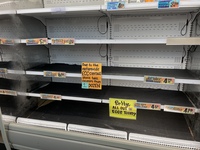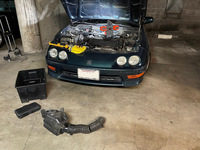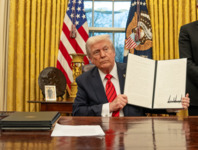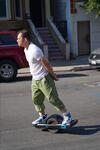 |
| Angelika/Mike Schilli |
|
Angelika Did you know that in San Francisco, the coastal road along Ocean Beach has recently been closed to cars? Here's how it happened: During COVID, the city's transportation department in San Francisco came up with the brilliant idea of establishing so-called "Slow Streets," which are traffic-calmed roads where pedestrians and children on bicycles could spread out (Rundbrief 09/2020), so you didn't feel so confined. "Slow Streets" still allowed access for residents and delivery people. They were not completely closed to cars. The program was so popular in San Francisco that some "Slow Streets" were kept that way even after the pandemic, such as Sanchez Street around the corner from us, which we still frequently use for our walks.
San Francisco is famously located by the Pacific Ocean and has several beaches in the western part of the city. "Ocean Beach" is the longest. Directly adjacent to "Ocean Beach" is the "Great Highway," a four-lane access road. "Highway" sounds somewhat grandiose because it brings to mind German autobahns. However, in the USA, "highways" generally refer to roads that can vary greatly in width and development. A "freeway" is more akin to a generously designed autobahn. I would describe the "Great Highway" more as a larger city street that, as mentioned, runs along the ocean beach.
The street has only a few traffic lights, and drivers make good progress. In April 2020, during the pandemic, the city closed a two-mile (3.2 km) section of the Great Highway, the so-called "Upper Great Highway," between Lincoln Avenue and Sloat Boulevard, so that the public could engage in physical activities there. This closure was also very popular, and no cars were allowed to drive on this section.
At the beginning of the pandemic, this was not a problem at all, as many people were working from home and traffic was light. Residents simply diverted to the neighborhood streets. But soon, voices grew louder to lift the closure. Supporters faced off against those residents who were annoyed by the traffic on the side streets with stop signs at every intersection. And lo and behold, in our city, where compromises are rare and everything is always debated and contested passionately and intensely, an agreement was reached in August 2021. The section remained closed to car traffic from Friday afternoon through the weekend and on public holidays. However, on weekdays, cars were allowed to speed through. Everyone had to give a little, but each side also got something they wanted.
In English, that's called a "win-win situation." This could have put the issue to rest, but wait, that would be too easy. The compromise that was worked out was limited as a pilot project and was set to expire at the end of 2025. The city wanted to collect data to see how much the closed section was used by pedestrians and cyclists, and what the impact was on traffic flows. I have no idea why the data collection took four years, but such things are not unusual in this city. Instead of properly evaluating the data and then deciding at city council whether the pilot project could continue as is or if changes needed to be made, they preferred to rely on the tried-and-true method of voter referendum through a so-called proposition. Five city representatives and our then-mayor, London Breed, pushed that Proposition K was on our ballot in November 2024, coinciding with the mayoral election in this city, and therefore a high voter turnout was expected.
An intense battle immediately erupted between supporters and opponents of the measure. Now you must know that these propositions are often tricky, because at first glance everything sounds just great. However, when you delve into the details, which only a few voters do, it looks quite different. Proposition K, for example, promised that not only would the 2-mile section be permanently closed to car traffic, but the road would be completely transformed into a park. Of course, everyone generally wants a nice new park right by the sea. What would be an argument against that? But Proposition K only promised the park, without plans for its financing or even ideas for its design.
Additionally, the Great Highway already faced challenges with large sand drifts several times a year due to its proximity to the ocean and the beach, and anyone planning a park should have taken this into account. On election day in November, 54% of citizens voted in favor of Proposition K, and as a result, the "Upper Great Highway" has been permanently closed to all vehicle traffic since March 14 of this year. Interestingly, most of the "no" votes for Proposition K came from the districts bordering the ocean, namely the "Outer Richmond" and "Sunset" neighborhoods. This is not surprising, as the people living there are the most affected by the closure in their daily lives.
Many of the neighborhood residents found it unfair that their voices didn't carry more weight. Consequently, there were efforts to recall city council member Joel Engardio, who represents the Sunset District and had advocated for the highway closure and the park. This is a common strategy among the politically dissatisfied in this city and in California in general. Nevertheless, the same Joel Engardio officially opened the new park in mid-April, now officially named "Sunset Dunes Park."
Currently, this only means that a few artworks have been painted on the street. Sculptures and fitness equipment are supposed to follow. Art is always good. Otherwise, the city plans to use the funding from the California Coastal Conservancy, one million dollars, to explore how the new park will affect traffic and the environment. It will also be examined how the potential rise of the sea level might, in turn, impact the park. Ahhh, we've been here before.
In any case, Michael, who is an enthusiastic cyclist, has scouted out a bicycle loop route from our home in Noe Valley to the close section of the Great Highway. The route first goes down through the Glen Park neighborhood, then through City College, through the University of San Francisco campus, then along the highway, up to Golden Gate Park and back through the park, onto the so-called 'Wiggle', to return through the Mission back to Noe Valley. It takes about two hours.
